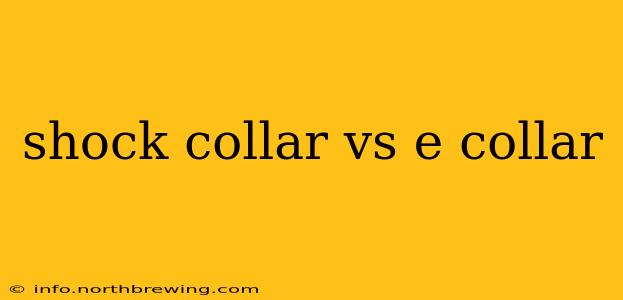The terms "shock collar" and "e-collar" are often used interchangeably, leading to confusion among pet owners. While they're closely related, there are crucial distinctions to understand before deciding which, if either, is right for your dog. This article will delve into the differences, address common concerns, and help you make an informed choice.
What is a Shock Collar?
A shock collar, also known as a "shock training collar," uses electrical stimulation as a correction method. It delivers a jolt of electricity to the dog's neck, aiming to deter unwanted behaviors. The intensity of the shock can be adjusted, but even the lowest settings can be unpleasant for the dog. Many animal welfare organizations strongly discourage the use of shock collars due to potential for causing pain, fear, and anxiety in dogs. The negative impact on the dog's well-being significantly outweighs any perceived training benefits.
What is an E-Collar?
An e-collar, or electronic collar, is a broader term encompassing various types of dog training collars. While some e-collars do use electrical stimulation (and are essentially shock collars), many others utilize different methods of correction or communication. These methods include:
- Vibration: A gentler alternative, vibration provides a tactile cue without causing pain.
- Tone: A simple auditory signal to alert the dog to their behavior.
- Static stimulation (shock): As mentioned above, this is the most controversial feature.
It's crucial to understand that "e-collar" is not synonymous with "shock collar." The term e-collar encompasses a wider range of training tools, and choosing one that uses only vibration or tone is vastly different from using one that delivers electric shocks.
Is an E-Collar the Same as a Shock Collar?
No, not all e-collars are shock collars. The term "e-collar" is an umbrella term; a shock collar is a type of e-collar that uses electric shocks as a training method. Many e-collars offer multiple correction modes, allowing trainers to choose the most suitable method for their dog and the specific training situation.
Are Shock Collars Cruel?
Many animal welfare organizations and veterinary professionals consider shock collars cruel. The use of pain as a training method is ethically questionable and can lead to negative consequences for the dog's mental and emotional well-being. These negative consequences can include:
- Fear and Anxiety: The unpredictable nature of shock can cause significant fear and anxiety.
- Aggression: Dogs subjected to painful stimuli may become aggressive.
- Behavioral Problems: Shock can worsen existing behavioral issues or create new ones.
- Physical Injury: Burns or skin irritation can occur.
What are the Alternatives to Shock Collars?
Fortunately, many humane and effective alternatives to shock collars exist:
- Positive Reinforcement Training: Rewarding desired behaviors with treats, praise, and toys is a proven and effective method.
- Clicker Training: A precise and effective way to mark desired behaviors.
- Head Halters and Harnesses: These tools provide gentle guidance and control.
- Aversive-Free Training: This approach focuses entirely on positive reinforcement and avoidance of any methods that inflict pain or discomfort.
Which Training Method is Best for My Dog?
The best training method depends on your dog's breed, temperament, age, and the specific behavioral issues you're addressing. Consulting a certified professional dog trainer is crucial. A qualified trainer can assess your dog's needs and recommend appropriate, humane, and effective training techniques. Avoid using any training method that causes your dog pain or distress.
Conclusion: Prioritize Humane Training Methods
While the terms "shock collar" and "e-collar" are sometimes conflated, it's crucial to understand their differences. While e-collars encompass a range of training tools, shock collars specifically use painful electrical stimulation. Humanitarian concerns surrounding the use of shock collars are significant, and effective, positive reinforcement training methods are widely available and preferable to any method involving pain or fear. Always prioritize your dog's well-being and consult with a qualified professional for guidance.
